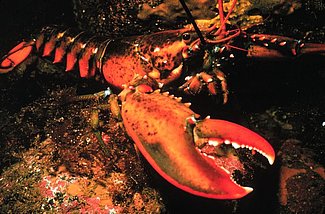Clean Ocean Advocate, August 2004

June’s creature feature was the American Lobster. Because of their hard outer shell and jointed legs, the lobster is related to shrimp, crabs, barnacles, and insects. Lobsters crawl rather than swim and aggressively compete for shelters in rocky areas. They eat mainly live food such as fish, small crustaceans, and mollusks. Lobsters have a fascinating life cycle, with part of its young life floating in the water to disperse. Have you ever wondered why lobsters turn red when cooked? Live American lobsters are usually olive green or greenish brown, though dusky orange and even bright blue lobsters are sometimes found. The major pigment in a lobster’s shell is called "astaxanthin." When chemically bound to proteins such as in the lobster’s shell, astaxanthin changes its red color to greenish or bluish. When lobsters are cooked, the heat breaks down the chemical bonds between astaxanthin pigment and the proteins, so that the pigment’s true color red is revealed. For more information, check out http://seagrant.gso.uri.edu/factsheets/fslobster.htm. Congratulations to Pam Semmel of Highlands for correctly identifying the Lobster.
This month’s creature feature has been found at many beaches this summer along the NJ coast. This clear, grape-like species resembles a jellyfish, but in fact is not. It is also incorrectly identified as fish eggs. To enter for a chance to win a COA T-shirt, send your guess by mail, fax, or e-mail (PO Box 505, Sandy Hook, NJ 07732; fax 732-872-8041, SandyHook@CleanOceanAction.org).
(What’s Cool at Ice and Coastal Creature Feature will appear every other month.)

